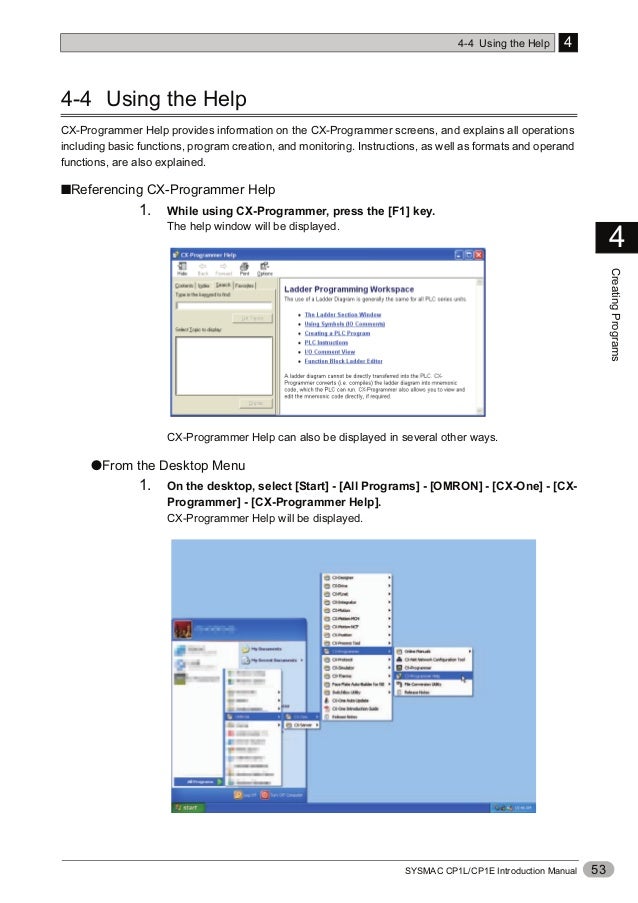Cx Programmer Ladder Diagram User Manual
Cx Programmer Ladder Diagram User Manual CX-Programmer Operation Manual before using the product. - This guide 3-1 (2014) Page 1 NO LADDER DIAGRAM Technical manual. SYSMAC One NSJ Series. Programmable Controllers. Instructions Reference Manual. Describes the ladder diagram programming instructions sup- ported by CS/CJ-series or NSJ-series PLCs. When programming, use this manual together with the Oper.


INDIRECT ADDRESSING Placing the character “*” ahead of operand from DM memory area allows us to use the indirect addressing. Simply put, value in the word *DM will be the address of the word that is the true operand. The picture below shows the MOV instruction with one operand given indirectly. The contents of location DM0003 equal “1433” which is actually a pointer marking the address DM1433 with contents “0005”. The result of this instruction will be moving the value “0005” from word DM1433 to word LR00. In order to use the indirect addressing, contents of the word that is the indirect operand have to be in BCD format. Besides that, value of the contents of indirect operand must not be greater than the number of addresses in DM area.
INSTRUCTION FORMAT Operand is the address of a word or a bit in PLC controller memory (most of the instructions has one or more operands). The common term for a word is just “operand” and in the case of bit we call it “operand bit”. Also, operand can be a direct numerical value marked by character “#” placed ahead of the value (i.e. #12, #345 etc).
The state of operand bit can be ON or OFF. ON means that its logic state equals “1”, while OFF stands for “0”.
Besides these, terms “set” and “reset” are also used. Symbols SV and PV commonly appear in instruction syntax. These abbreviations stand for “ Set Value” and “ Present Value” and are most frequently encountered with instructions concerning counters and timers. DIFFERENTIAL INSTRUCTION FORM Differential form is supported by almost all of the instructions. What differs this form from the classical one is the character “@” placed ahead of the name of the instruction. This form ensures that the instruction with condition fulfilled will not be executed in every cycle, but only when its condition changes state from OFF to ON. Differential from is commonly used because it has a lot of applications in real-life problems.
Free Installer Swish. DIFFERENCE BETWEEN BINARY AND BCD REPRESENTATIONS OF WORD CONTENTS Generally, there are two dominant ways for comprehending values of memory locations. The first is binary and is related to the contents of the word which is treated as a union of 16 bits. Value is calculated as a sum of each bit (0 or 1) multiplied by 2 on power n, where n represents the position of bit in the word. Bit of the least value has position zero, while bit of greatest value has position 15.
BCD is an abbreviation for “Binary Coded Decimal number”. It is nothing more than representing each decimal figure with 4 bits, similar to binary coding hence the name comes from. The picture below shows the difference between binary and BCD representations of the number. Same contents can be interpreted as either 612 or 264. For that reason, proper attention should be given to the format of the value within the word that will be sent to the instruction as an operand. Sequence Output Instructions Instruction Mnemonic Code Function OUTPUT OUT 0 Outputs the result of logic to a bit. OUT NOT OUT NOT 0 Reverses and outputs the result of logic to a bit.
SET SET 0 Force sets (ON) a bit. RESET RESET 0 Force resets (OFF) a bit. KEEP KEEP 11 Maintains the status of the designated bit. DIFFERENTIATE UP DIFU 13 Turns ON a bit for one cycle when the execution condition goes from OFF to ON. DIFFERENTIATEDOWN DIFD 14 Turns ON a bit for one cycle when the execution condition goes from ON to OFF.
Sequence Control Instructions Instruction Mnemonic Code Function NO OPERATION NOP 00 --- END END 01 Required at the end of the program. INTERLOCK IL 02 It the execution condition for IL(02) is OFF, all outputs are turned OFF and all timer PVs reset between IL(02) and the next ILC(03). INTERLOCKCLEAR ILC 03 ILC(03) indicates the end of an interlock (beginning at IL(02)). JUMP JMP 04 If the execution condition for JMP(04) is ON, all instructions between JMP(04) and JME(05) are treated as NOP(OO). JUMP END JME 05 JME(05) indicates the end of a jump (beginning at JMP(04)). Convert Fs9 Traffic Files To Fsx Plane. Data Movement Instructions Instruction Mnemonic Code Function MOVE (@)MOV 21 Copies a constant or the content of a word to a word.
MOVE NOT (@)MVN 22 Copies the complement of a constant or the content of a word to a word. BLOCKTRANSFER (@)XFER 70 Copies the content of a block of up to 1,000 consecutive words to a block of consecutive words. BLOCK SET (@)BSET 71 Copies the content of a word to a block of consecutive words. DATA EXCHAGE (@)XCHG 73 Exchanges the content of two words. SINGLE WORDDISTRIBUTE (@)DIST 80 Copies the content of a word to a word (whose address is determined by adding an offset to a word address). DATA COLLECT (@)COLL 81 Copies the content of a word (whose address is determined by adding an offset to a word address) to a word. MOVE BIT (@)MOVB 82 Copies the specified bit from one word to the specified bit of a word.